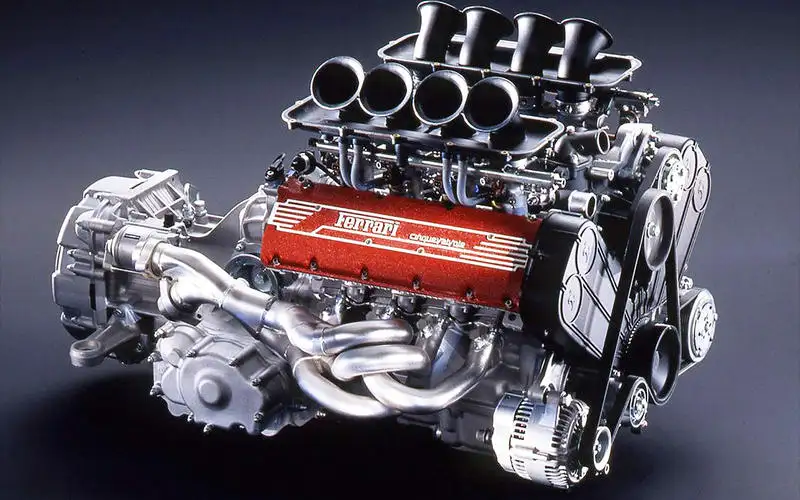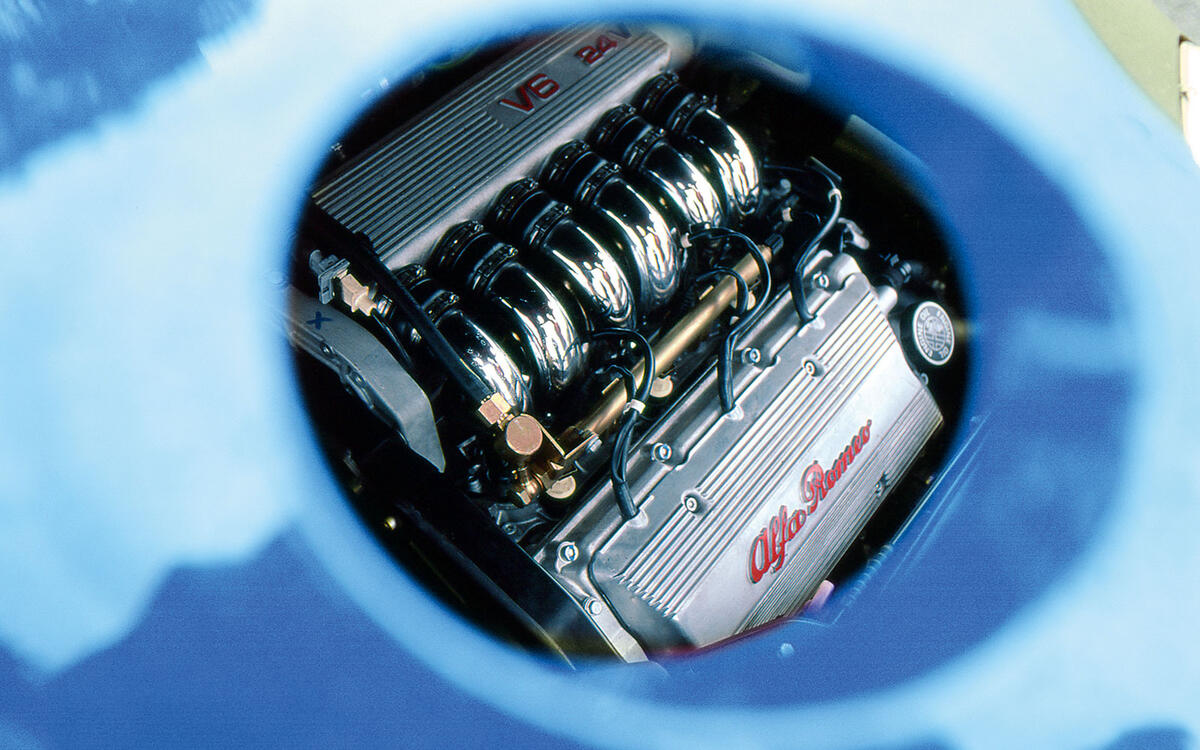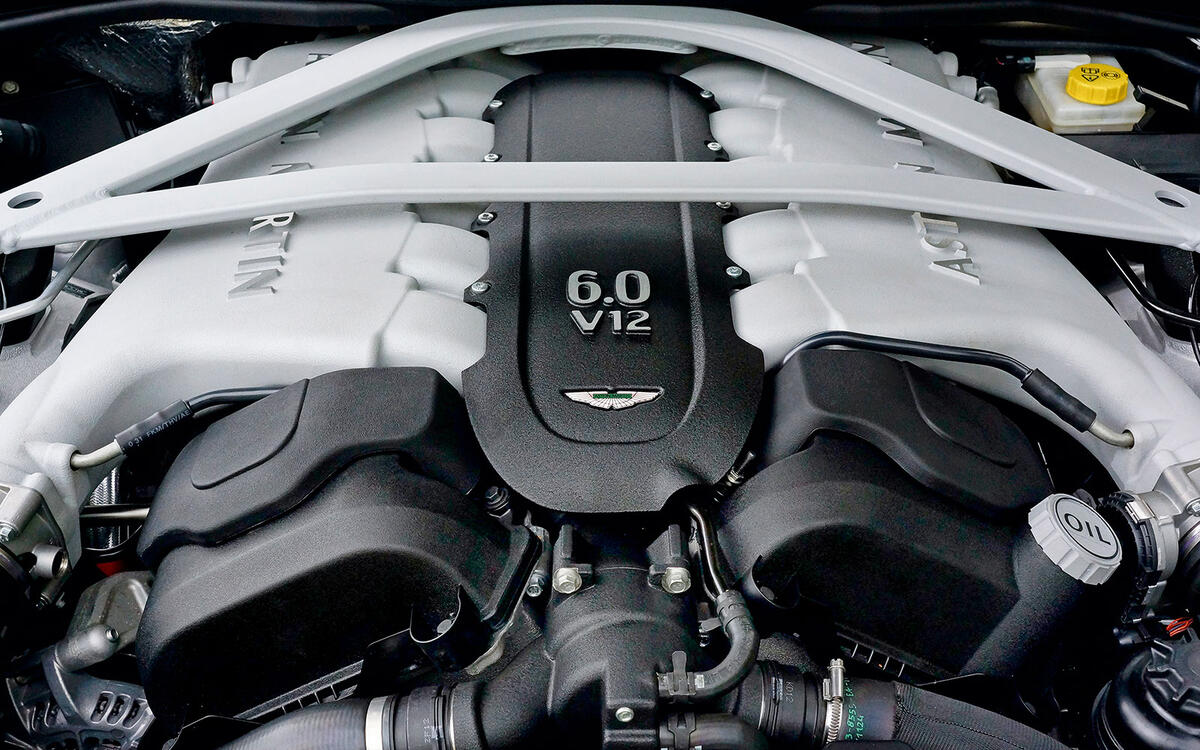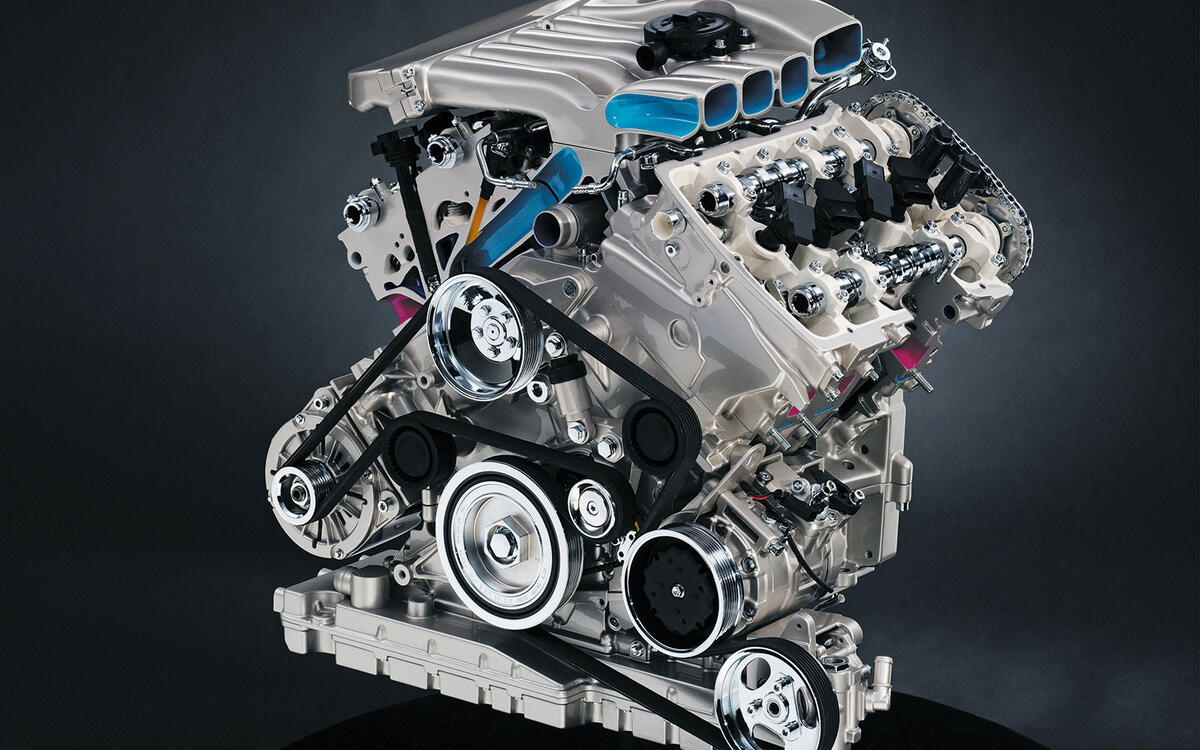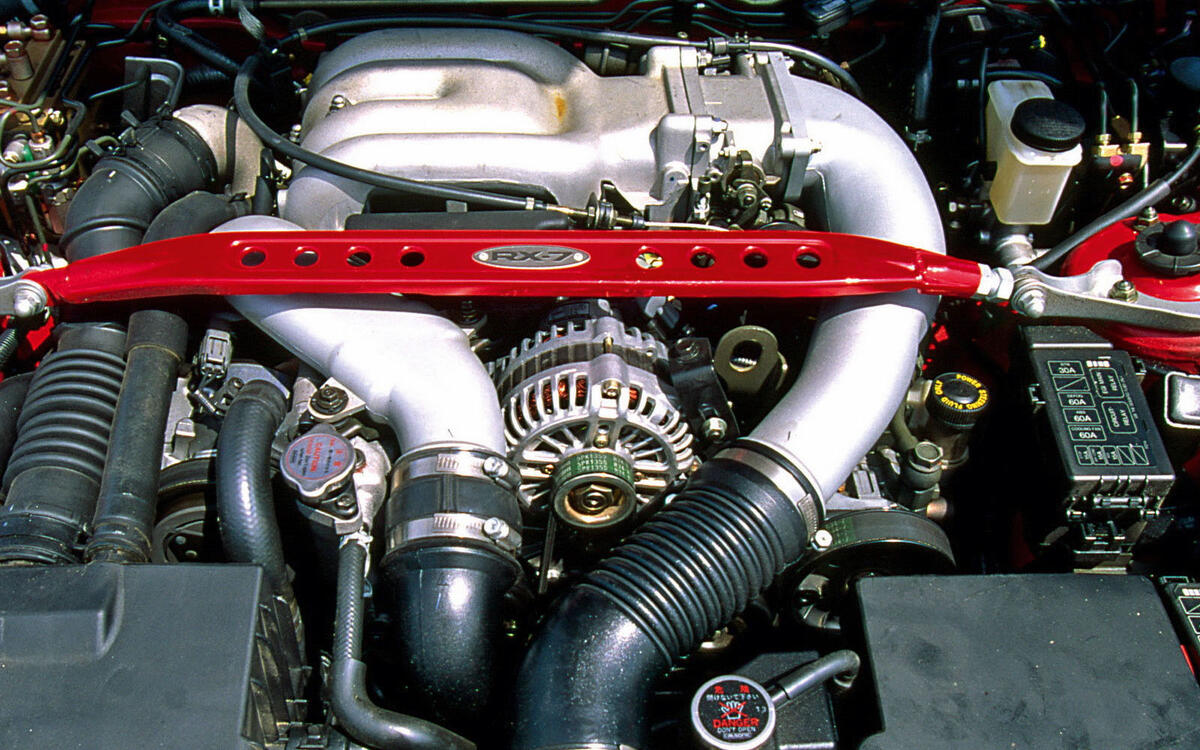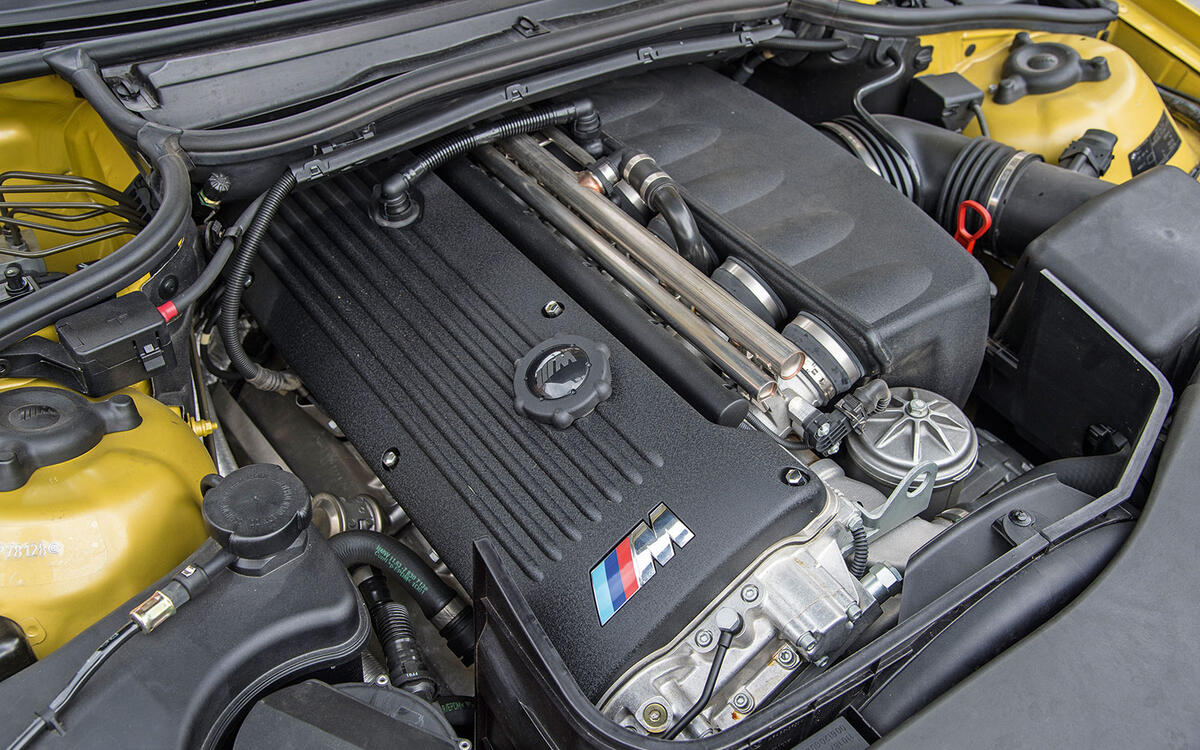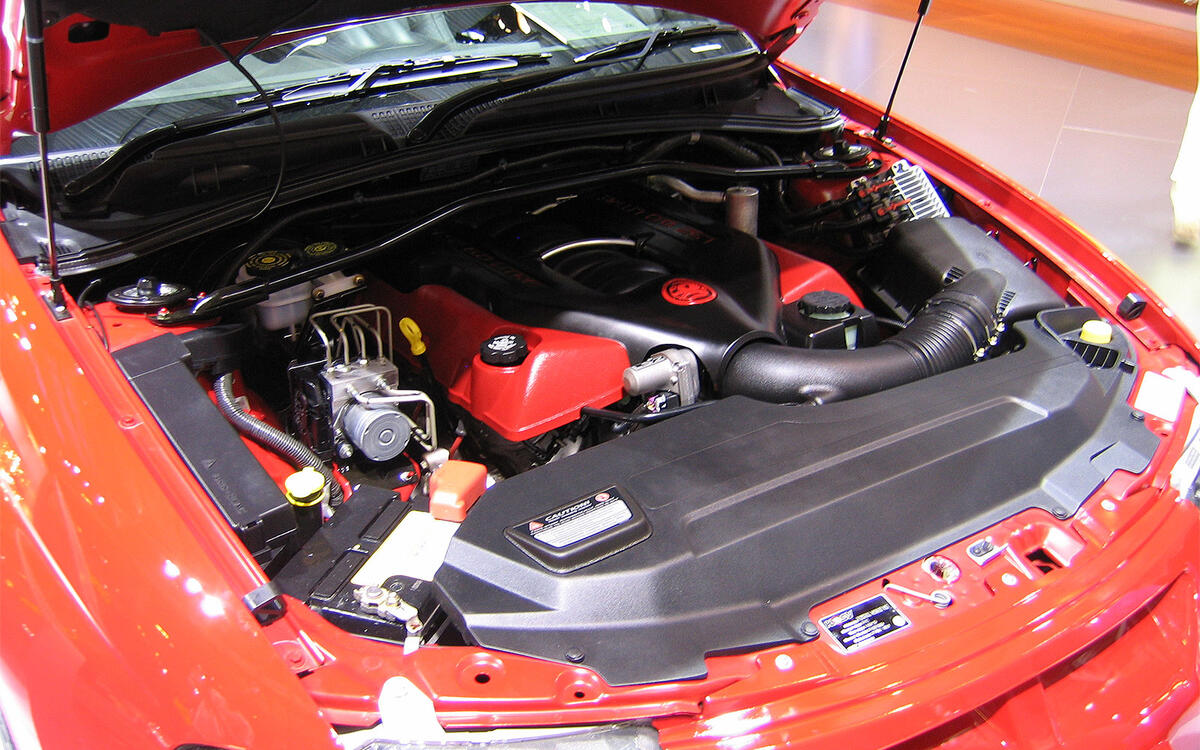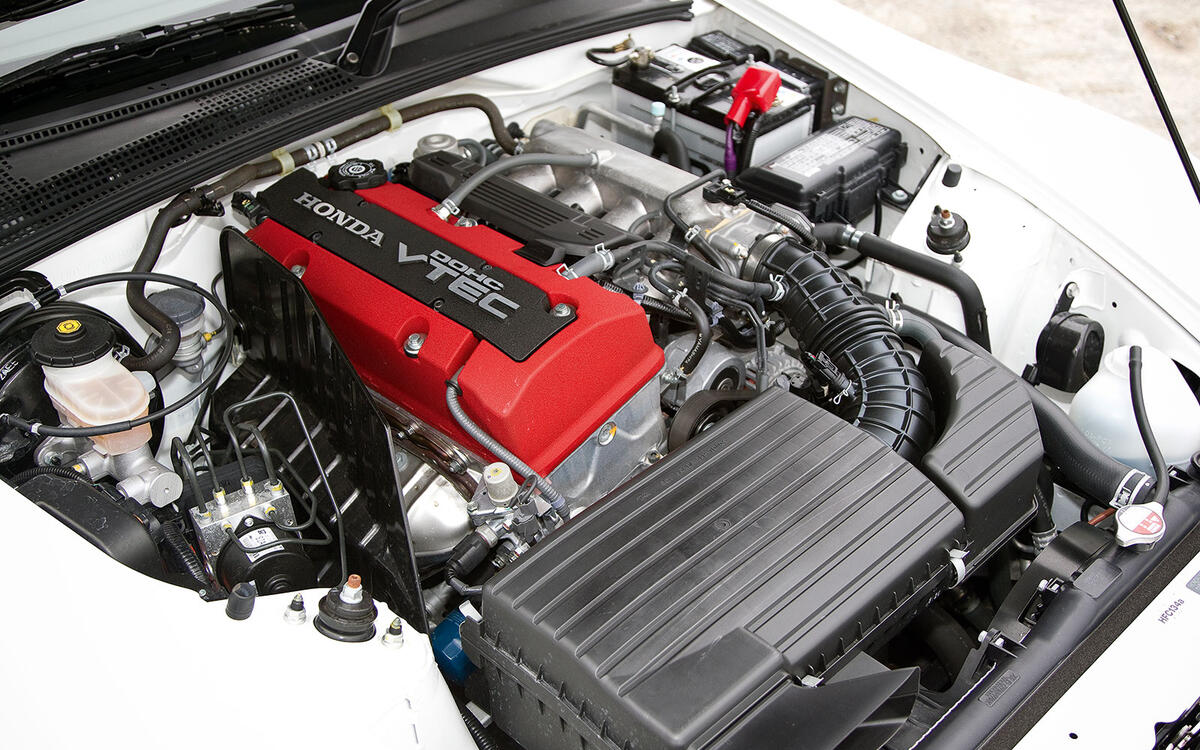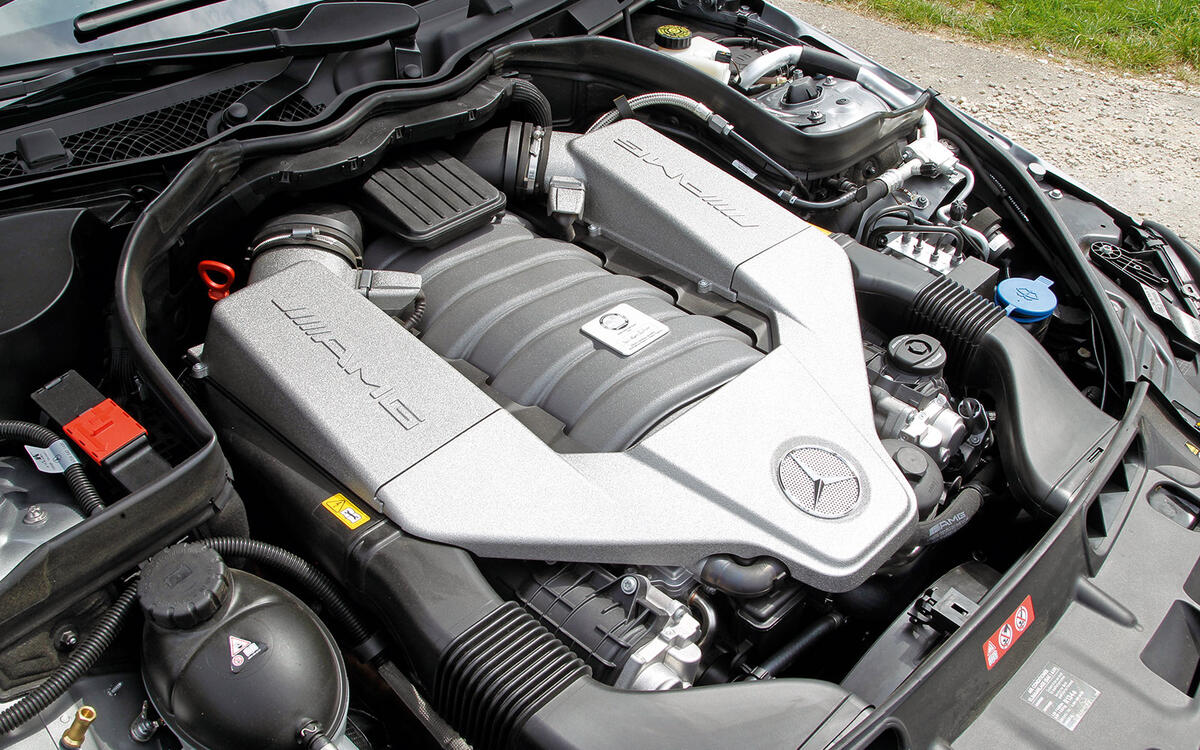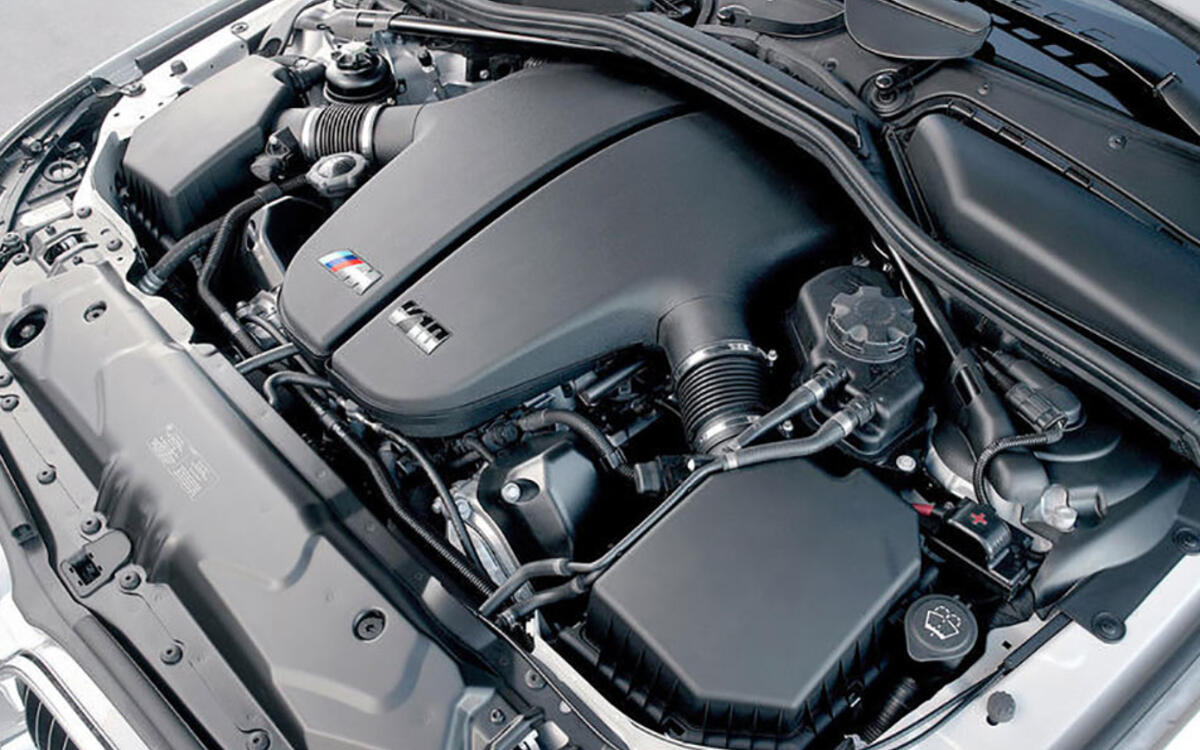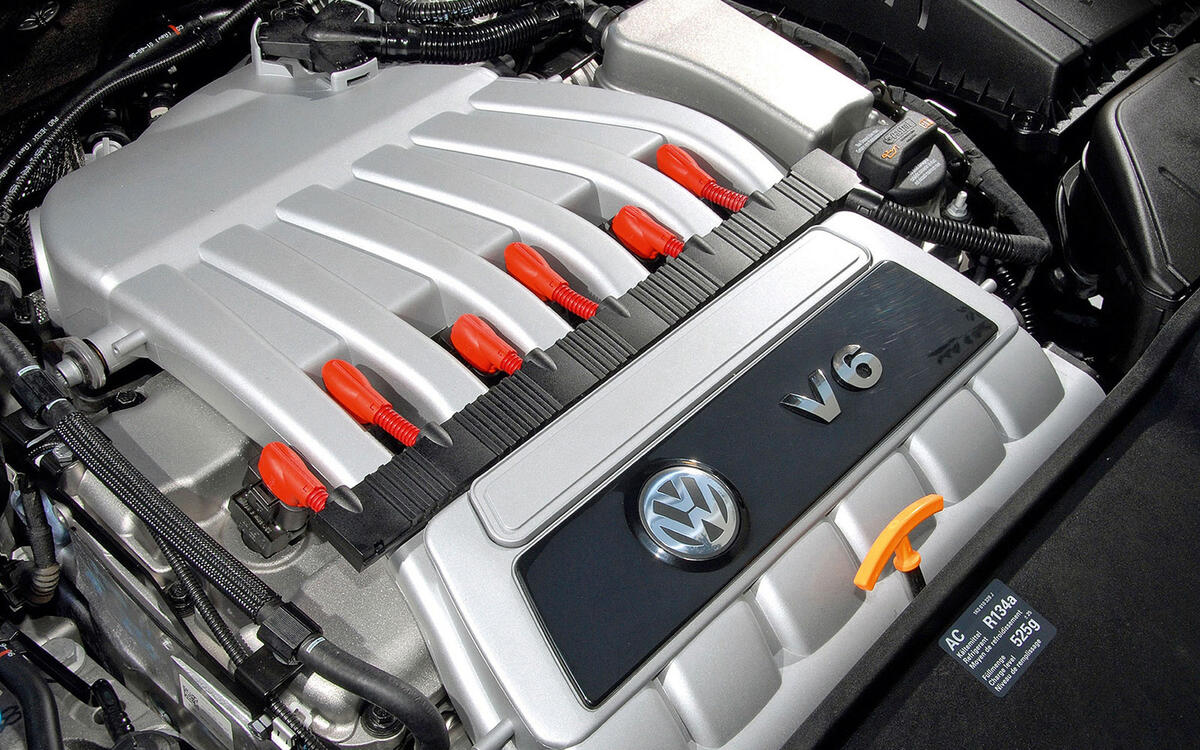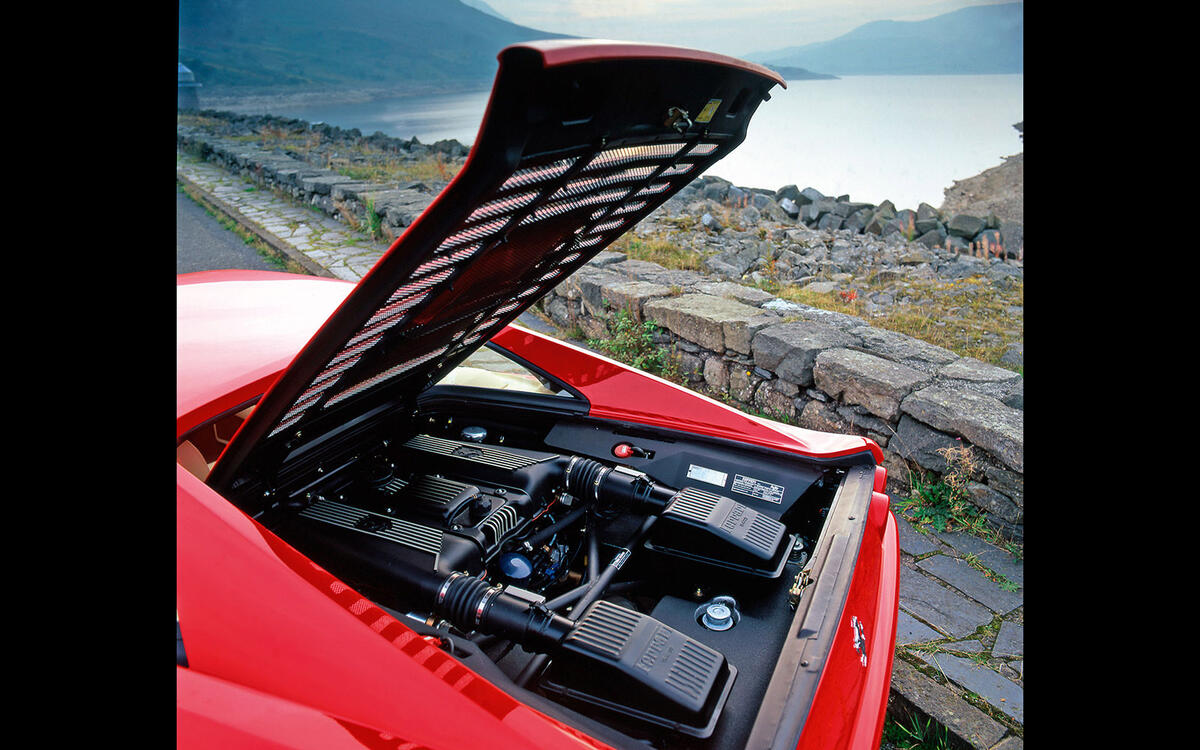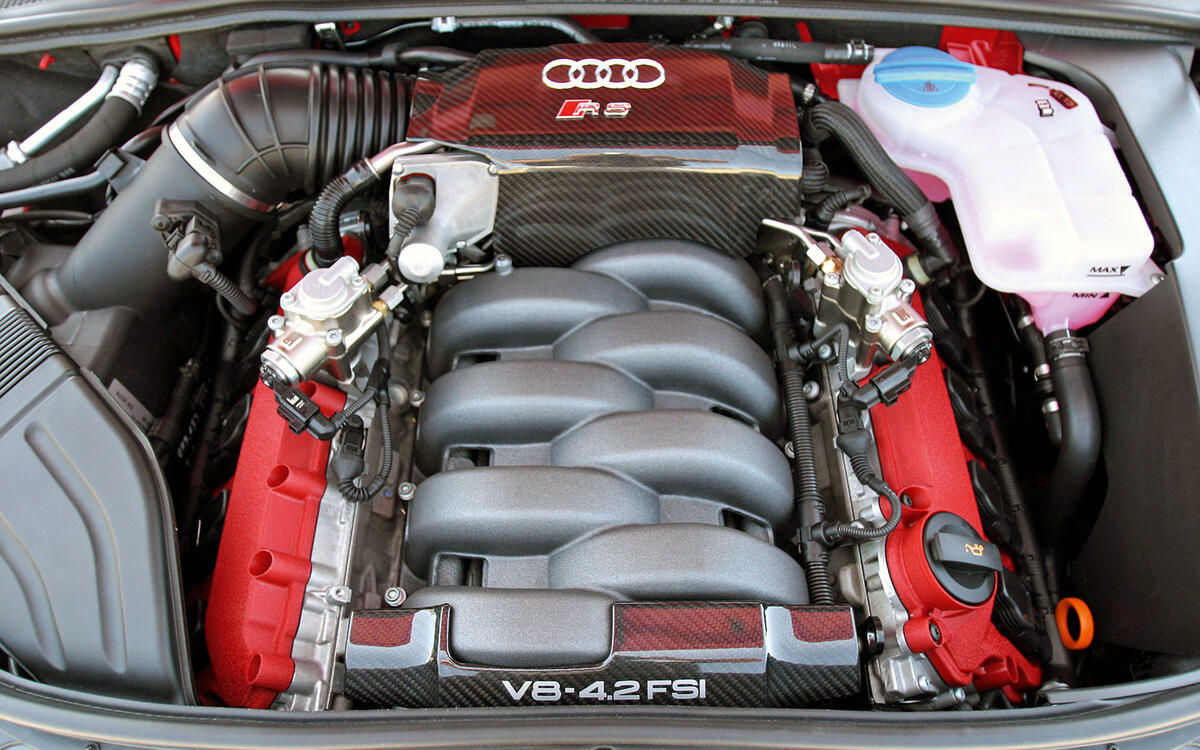 Slide of
Slide of
Legend has it that Enzo Ferrari once said some variation of ‘when you buy a Ferrari, you are paying for the engine. The rest you get for free.’
Was it all just bluster and provocation? Perhaps, but there’s no doubt the Old Man considered a sports car’s engine to be its very heart. As Enzo knew all along, a really great motor is as good a reason to buy a car as any other.
That’s as true now as it ever was. In this feature we’ll highlight 14 cars that are powered by engines so spectacular, or unusual, or downright incongruous that you’ll need no other reason to want to buy one. Most of the 14 cars we’ve chosen are very affordable, too. Whether you favour eight cylinders or 12, natural aspiration or turbocharging, high rpm screamers or low-end torque monsters, here’s how to bag yourself a car with a truly great engine:
PICTURED: V8 engine from a Ferrari F355
 Slide of
Slide of
Alfa Romeo GTV V6 (1995-2004)
Only if an engine is on display, as it is in a mid-engined Ferrari or an Audi R8, should the way it looks be of any real concern. With its sextet of chrome inlet tracts bending elegantly through 60 degrees, however, and straked cam covers proudly carrying the Alfa Romeo script, the GTV’s six-cylinder is as gorgeous to behold with the eye as with the ear.
Alfa’s ‘Busso’ V6 served in numerous models between 1979 and 2005, including the 147 and 156 GTA performance cars, but only the GTV’s strikingly pretty, Pininfarina-penned bodywork did it aesthetic justice.
Originally designed by Giuseppe Busso the engine grew in displacement from 2.0-litres to 3.2 during its 26-year lifespan. It was revised in the late Nineties with a four-valve-per-cylinder valvetrain. Four versions of the Busso were found in the GTV, outputs ranging from 189 to 237bhp.
 Slide of
Slide of
Alfa Romeo GTV V6 (1995-2004) - engine
The most potent 3.2-litre model was only produced for a short time right at the end of the GTV’s life, so you’ll have a wait on your hands if that’s the version you’re determined to find today. The 3.0-litre is much more common, with prices starting at just £2300.
You’ll need to do your homework when buying a GTV, but they’re not as hopelessly fragile as Alfa Romeo’s reputation might suggest. Cambelts should be changed every four years and impeccable service and MOT histories are a must.
The V6 engines are known to consume oil and some may have been allowed to run at a dangerously low level as a result. Galvanised bodies and plastic bumpers should mean rust isn’t a problem, but some cars are starting to corrode around the rear arches and jacking points nonetheless. Values, finally, are on the up.
Used examples in the UK are priced from £2495-£18,000.
 Slide of
Slide of
Aston Martin DB9 (2004-2016)
‘The DB9 is not that quick,’ said our road testers of Aston Martin’s grand tourer several years ago. ‘It hits 62mph in 4.6 seconds. But the nature of that performance? Well, that remains something else again. There’s still nothing to match the sound of a large capacity, normally aspirated V12 in full flight.’
Words to live by. In this age of 400bhp fast hatches the DB9’s straight line performance is even less remarkable today than it was when the car was new, but each time you hear the 5.9-litre V12 howl around to its rev limiter you’ll care less and less.
 Slide of
Slide of
Aston Martin DB9 (2004-2016) - engine
As once was written in these pages, though, there’s no such thing as a cheap Aston, just a troublesome one. The key is to find a car with impeccable history and a fastidious owner. The manual transmission, much rarer than the auto, is likely to be more desirable in future, too. Used UK prices range from £13,995 to £144,995.
 Slide of
Slide of
Volkswagen Passat W8 (2002-2005)
Finding out there was an eight-cylinder VW Passat for the first time was a lot like realising the quiet guy in your office is also the lead singer of a local Metallica tribute band. Mostly, the Passat is so determinedly worthy and functional that it has no personality whatsoever (incidentally, that’s precisely why it’s so good at what it does), but the W8 was different. In estate guise especially, it’s one of the coolest semi-sensible cars £5000 will buy.
The W8 cylinder layout is also one of the most unusual configurations of recent times. ‘W’ is actually a little misleading; it’s more accurate to say the engine was laid out like two very narrow angle V4s working on a common crankshaft at 72 degrees to one another.
 Slide of
Slide of
Volkswagen Passat W8 (2002-2005) - engine
At a stretch you could even claim it’s half a Bugatti Chiron motor, minus the turbos. The 4.0-litre unit developed 271bhp in creamy, woofly fashion. With a set of winter tyres, the four-wheel drive Passat W8 could well be the perfect hack. UK used prices range from £5490 to £8990.
 Slide of
Slide of
Mazda RX-7 (1992-2002)
The third-generation Mazda RX-7 might just be the prettiest Japanese car of all time. Whereas many designs from that corner of the globe are characterised by sharp edges and angular forms, the RX-7 is fluency itself. But that isn’t what defines the RX-7.
 Slide of
Slide of
Mazda RX-7 (1992-2002) - engine
Instead, it’s the twin-turbocharged 1.3-litre twin-rotor Wankel engine that stands out. Smooth and free-revving, it develops as much as 276bhp. Used prices range from £10,000 to £20,000.
 Slide of
Slide of
Westfield Megabusa (2000-onwards)
Sticking a peaky, torque-lite motorcycle engine into a car makes no sense whatsoever…unless that car happens to weigh less than 500kg. Borrowing the 178bhp, 1.3-litre four-cylinder engine and six-speed sequential gearbox from a Suzuki Hayabusa, the Westfield Megabusa is one of the most thrilling cars on the road.
 Slide of
Slide of
Westfield Megabusa (2000-onwards) – engine
With peak power arriving at close to 10,000rpm, how can it be anything but? UK used prices range from £11,000 to £15,000, though it doesn’t look like any made it to the US.
 Slide of
Slide of
BMW M3 (E46) (2000-2006)
BMW’s M division forged its reputation on straight-six engines. The very first M-car, the M1 supercar, used a straight-six and so did early versions of the M5. What characterises inline six-cylinders is smoothness; they’re in near enough perfect primary and secondary balance, meaning they run without the vibrations that afflict most other engine layouts.
The E46 M3, the third model in the dynasty, was powered by one of the sweetest and freest revving straight-sixes of all time. Displacing 3.2-litres it produced 338bhp at heady 7900rpm and 269lb ft. E46 values bottomed out a few years ago, but since then they’ve stabilised and steadily climbed back up.
 Slide of
Slide of
BMW M3 (E46) (2000-2006) - engine
A coupe with the six-speed manual gearbox - far preferable to a convertible with the SMG transmission - and fewer than 100,000 miles, meanwhile, go for strong and rising money now.
Many cars will have suffered cracked boot floors and rear subframes, but the remedial work should have been carried out by now. Used prices in the UK range from £6500 to £35,995.
 Slide of
Slide of
Vauxhall Monaro (2004-2007)
The Chevrolet small-block V8 is an automotive phenomenon. It is to the motoring world what the little black dress is to fashion; enduring and iconic. Between 1955 and 2003 close to 100 million small-block V8s were built for use in competition cars, sports cars, saloons, SUVs, trucks, hotrods and any number of homemade conversions. Having ignited the muscle car movement it is the reason Americans fell in love with the V8.
In fact, considering its longevity, its enormous range of applications and the regard it’s held in among enthusiasts, the small-block might well be the most culturally significant internal combustion engine of all time.
A huge number of small-block derivatives were built with various displacements and power outputs, but the basic design of the block didn’t change for 48 years. One of the surest, most hassle-free ways into small-block ownership in the UK comes via Australia in the shape of the Vauxhall Monaro, a rebadged Holden.
 Slide of
Slide of
Vauxhall Monaro (2004-2007) - engine
Strictly speaking, the Monaro didn’t actually use the original Chevrolet small-block, but instead that engine’s immediate successor, the LS (which is still considered a small-block V8). Making its UK debut in 2004 the Monaro was powered by either a 5.7-litre with 328bhp or a 6.0-litre that developed 376bhp (pictured).
These brawny, high-capacity V8s often feel less potent than their massive displacements would suggest, typically because they drive through very long gear ratios, but the thunderous V8 soundtrack and traction-defeating torque do endow the Monaro with an authentic muscle car character.
Prices range from £7990 to £17,495.
 Slide of
Slide of
Pontiac GTO
Soggy UK weather and salted winter roads are causing some cars to rust. The all-aluminium engines are proving to be bulletproof, though.
The Monaro is a rare and incongruous sight on our narrow roads and they don’t come up for sale very often. UK used prices range from £6500 to £15,000. This car did also reach the US in 2004, where it was known as the Pontiac GTO (pictured).
 Slide of
Slide of
Honda S2000 (1999-2009)
The Honda S2000 hails from a time when big power was hard to come by. Its normally-aspirated four-cylinder motor, codenamed F20C, employs all manner of exotic hardware and motorsport-derived trickery that allow it to rev to 9000rpm.
The V-TEC system engages the higher lift cams at 6000rpm, at which point the engine explodes into serrated, ear-splitting life. The result is a peak power output of 237bhp - enormous for a normally-aspirated 2.0-litre - with torque rated at a somewhat skinny 155lb ft.
These were the measures engine designers had to resort to in the late Nineties. Two decades later big power comes easily; turbocharging is so refined and reliable these days it’s become ubiquitous, and 9000rpm redlines are saved for high-end sports cars only. The S2000 serves up the ferocious power delivery of a Porsche 911 GT3, but at a fraction of the cost. Values are on the rise, too.
 Slide of
Slide of
Honda S2000 (1999-2009) - engine
The S2000 is an exciting and involving car to drive, but it’s far from perfect. The seating position is odd, with the seat set far too high, and the spiky handling and lack of traction control (on earlier cars, at least) has seen many S2000s backed through hedgerows or wrapped around lampposts.
From 2004 onwards the chassis setup was revised with softer springs and anti-roll bars in an effort to tame the handling, while traction control became an option in 2006.
Naturally, an engine as highly-strung as the F20C demands care and attention. The oil should be changed every six months or 6000 miles and it can burn through the stuff at a rate of one litre every 1000 miles. If you suspect the seller hasn’t kept on top of oil changes, walk away. Find a good car, though, and it’ll be worth more in a year than it is today. UK prices range from £4990 to £22,500.
 Slide of
Slide of
Mercedes-Benz C63 AMG Coupe (2011-2015)
The current Mercedes-AMG C63 is better in every objective way than the model it replaced. In one very important subjective way, though, the previous car had the new one licked.
It was so much more characterful, thanks entirely to its thumping, normally-aspirated 6.2-litre V8. The M156 engine is muscular and torque-rich, and it revs out so dramatically you’d swear there weren’t eight pistons firing up and down in the block, but eight lump hammers.
 Slide of
Slide of
Mercedes-Benz C63 AMG Coupe (2011-2015) - engine
The W204 C63 was at its best in Coupé trim. In fact, the really special model was the run-out 507 - ignoring, for a moment, the head-banging lunatic that was the Black Series - but you’ll have to fork out serious cash for a 507 today. That’s close to double what you’ll pay for a regular C63 Coupé.
Aside from running costs - don’t expect any more than 17mpg - there isn’t too much that should put you off. Rear cylinder head bolts can corrode and fail, and cam lifters can become noisy and ultimately give up, but both issues are rare.
UK prices range from £23,000 to £37,000 - Black Series versions cost from £55,000.
 Slide of
Slide of
BMW M5 (E60) (2005-2010)
The E60 BMW M5 isn’t at all like the Honda S2000, except in one important way. In the middle of the last decade the German super saloon horsepower race was in full swing.
To keep pace with rivals from Audi and Mercedes, BMW’s M-division went to extreme lengths with the new M5’s engine, just as Honda had done six year earlier, eventually developing what will always be remembered as the most exotic powerplant ever fitted to a saloon (or estate) car.
At the time, a turbocharged M-car was still close to unthinkable, after all, and high-performance BMWs were still defined by their engines more than anything else.
 Slide of
Slide of
BMW M5 (E60) (2005-2010) - engine
A 5.0-litre, normally-aspirated V10 that revs to 8250rpm, the S85 is all-aluminium. It uses double-VANOS variable valve timing (meaning it operates both the intake and exhaust camshafts), 10 electronically-actuated individual throttle bodies, high-spec Mahle pistons and an elaborate oil supply system with what BMW refers to as a ‘quasi-dry sump’ lubrication.
The block and heads were cast at the same foundry as BMW’s Formula 1 engines of the era.
 Slide of
Slide of
BMW M5 (E60 – US market version) (2005-2010)
The results were 507bhp and 384lb ft, and an engine the likes of which we’d never seen outside of a six-figure supercar. Modern super saloon engines, downsized and turbocharged, may well be more powerful and fuel efficient, but they’re all utterly forgettable compared to the fierce and charismatic S85. It’s a pity the SMG gearbox feels so outdated, however.
E60 M5s are not expensive to buy today, but they can be ferociously expensive to run. Aside from the car’s enormous thirst, owners routinely tell tales of five-figure warranty claims, which serves as a useful warning; if you’re not covered by a warranty, be it aftermarket or underwritten by BMW, an E60 M5 probably isn’t worth the risk. UK prices range from £12,000 to £30,000.
Lucky Americans even got a US-market M5 with a stick-shift option (pictured).
 Slide of
Slide of
Volkswagen Golf R32 (2005-2008)
Despite being the halo model in the VW Golf line up the mk5 R32 was actually inferior to the cheaper, slower GTI in every respect, except one.
Its 247bhp 3.2-litre V6 wasn’t massively more powerful than the GTI’s 197bhp 2.0-litre turbo, but it was much more characterful and it sounded far better at full chat, too.
 Slide of
Slide of
Volkswagen Golf R32 (2005-2008) - engine
The engines are bombproof, but the Haldex four-wheel drive system needs servicing every 40,000 miles. UK prices range from £4490 to £16,790.
 Slide of
Slide of
Ferrari F355 (1994-1999)
Few man-made instruments have ever created a more intoxicating noise than a Ferrari F355’s flat-plane crank V8 at high engine speeds, particularly when it breathes through an aftermarket exhaust. Equipped with a Tubi system, for instance, the F355 sounds like nothing else on the road.
 Slide of
Slide of
Ferrari F355 (1994-1999) - engine
Ferrari ownership - particularly ownership of a 20-year old model - is not something to embark upon lightly. Even if the car is a good one, running costs will be heroic. But the F355 is highly regarded and now has prices to match; in the UK they range from £14,600 to £159,995.
 Slide of
Slide of
Subaru Impreza WRX STi (1994-2000)
The boxer engine takes its name from the pairs of horizontally opposed pistons that move towards one another on the power stroke, like boxers throwing punches at one another.
 Slide of
Slide of
Subaru Impreza WRX STi (1994-2000) - engine
One of the most famous engines of this type is the turbocharged Subaru four-cylinder that powered the Impreza and was heard along rally stages around the world in all its offbeat warbling glory. The WRX STi has already achieved modern classic status and is rising in value. UK prices range from £7500 to £14,000.
 Slide of
Slide of
Audi RS4 (B7) (2006-2008)
A generation ago we didn’t know how good we had it. For a few short years towards the end of the last decade the three main protagonists in the sports saloon segment were all powered by V8 engines of remarkable character and voice.
With not a turbocharger in sight the BMW M3, Mercedes C63 AMG and Audi RS4 all derived their motive force from atmospheric bent-eights. It’ll never happen again.
Sports saloon group tests of that era were cacophonous and rude, scored triumphantly by three-piece V8 orchestras. The equivalent triple test today is muted by comparison, each of the three cars now muffled by twin turbochargers and just one, the Mercedes, still preferring eight cylinders to six.
 Slide of
Slide of
Audi RS4 (B7) (2006-2008) - engine
In many ways the RS4 was the runt of the sports saloon litter, lacking both the dynamic precision of the M3 and the over-engined charisma of the C63. That doesn’t mean it was without its strengths, though; you simply had to look a little harder for them. In fact, the RS4 feels like a much better car in isolation than it does in the presence of its more boastful rivals.
It isn’t the sort of thing you grab by the throat, but as a car to whip along a cresting, twisting country road at seven or eight tenths, the four-wheel drive Audi was very good indeed. That Quattro drivetrain gave it a level of wet weather security the M3 and C63 couldn’t match while its motor - 4.2-litres of high revving V8 - was a masterpiece.
The RS4 isn’t rewarding enough as a driver’s car that you would keep one locked away for weekend jollies, the way you might an M3, but as an everyday machine (albeit a thirsty one), it’s almost unbeatable at the money. UK prices range from £9995 to £32,500.
The car world has given us some mighty fine engines – here’s a selection of the best
Advertisement

